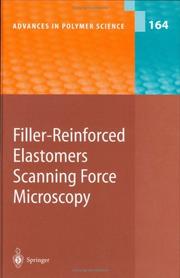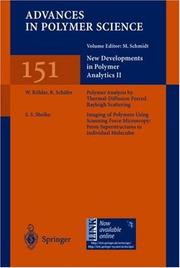| Listing 1 - 9 of 9 |
Sort by
|
Article
Year: 2001
Abstract | Keywords | Export | Availability | Bookmark
 Loading...
Loading...Choose an application
- Reference Manager
- EndNote
- RefWorks (Direct export to RefWorks)
Book
ISBN: 0195062701 9780195062700 Year: 1991 Publisher: Oxford: Oxford university press,
Abstract | Keywords | Export | Availability | Bookmark
 Loading...
Loading...Choose an application
- Reference Manager
- EndNote
- RefWorks (Direct export to RefWorks)
Article
Year: 2000
Abstract | Keywords | Export | Availability | Bookmark
 Loading...
Loading...Choose an application
- Reference Manager
- EndNote
- RefWorks (Direct export to RefWorks)
POLYMER MORPHOLOGY --- SCANNING FORCE MICROSCOPY --- ULTRATHIN FILMS

ISBN: 128044178X 0198022816 9786610441785 0195344693 1602566283 9780198022817 9780195092042 019509204X 019509204X 0197732615 Year: 2023 Publisher: New York ; Oxford University Press,
Abstract | Keywords | Export | Availability | Bookmark
 Loading...
Loading...Choose an application
- Reference Manager
- EndNote
- RefWorks (Direct export to RefWorks)
Includes information about the mapping of a variety of forces across surfaces, including basic theory, instrumentation, and applications. This book also includes research in SFM and a bibliography. It will be useful for academic and industrial researchers using SFM.
Scanning force microscopy. --- Surfaces (Physics) --- Physics --- Surface chemistry --- Surfaces (Technology) --- SFM (Microscopy) --- Scanning tunneling microscopy --- Experimental solid state physics

ISBN: 3540005307 3540364382 Year: 2003 Publisher: Berlin Springer
Abstract | Keywords | Export | Availability | Bookmark
 Loading...
Loading...Choose an application
- Reference Manager
- EndNote
- RefWorks (Direct export to RefWorks)
Elastomers. --- Scanning force microscopy. --- Elastomers --- Scanning force microscopy --- SFM (Microscopy) --- Scanning tunneling microscopy --- Elastomeric materials --- Reinforced elastomers --- Polymers --- Plastics --- Rubber --- Chemical engineering. --- Polymers . --- Condensed matter. --- Physical chemistry. --- Analytical chemistry. --- Industrial Chemistry/Chemical Engineering. --- Science, Humanities and Social Sciences, multidisciplinary. --- Polymer Sciences. --- Condensed Matter Physics. --- Physical Chemistry. --- Analytical Chemistry. --- Analysis, Chemical --- Analytic chemistry --- Chemical analysis --- Chemistry, Analytic --- Chemistry --- Chemistry, Theoretical --- Physical chemistry --- Theoretical chemistry --- Condensed materials --- Condensed media --- Condensed phase --- Materials, Condensed --- Media, Condensed --- Phase, Condensed --- Liquids --- Matter --- Solids --- Polymere --- Polymeride --- Polymers and polymerization --- Macromolecules --- Chemistry, Industrial --- Engineering, Chemical --- Industrial chemistry --- Engineering --- Chemistry, Technical --- Metallurgy

ISSN: 14344904 ISBN: 1280305002 9786610305001 3540266410 3540401865 3642072860 Year: 2005 Publisher: Berlin ; New York : Springer,
Abstract | Keywords | Export | Availability | Bookmark
 Loading...
Loading...Choose an application
- Reference Manager
- EndNote
- RefWorks (Direct export to RefWorks)
This volume contains a comprehensive collection of overview articles on novel microscopy methods for imaging magnetic structures on the nanoscale. Written by leading scientists in the field the book covers synchrotron based methods, spin polarized electron methods, and scanning probe techniques. It will be a valuable source of reference for graduate students and newcomers to the field.
Nanostructures. --- Magnetic force microscopy. --- MFM (Microscopy) --- Scanning force microscopy --- Nanoscience --- Physics --- Nanotechnology. --- Optical materials. --- Materials. --- Engineering. --- Optical and Electronic Materials. --- Metallic Materials. --- Condensed Matter Physics. --- Engineering, general. --- Construction --- Industrial arts --- Technology --- Engineering --- Engineering materials --- Industrial materials --- Engineering design --- Manufacturing processes --- Optics --- Materials --- Molecular technology --- Nanoscale technology --- High technology --- Electronic materials. --- Metals. --- Condensed matter. --- Condensed materials --- Condensed media --- Condensed phase --- Materials, Condensed --- Media, Condensed --- Phase, Condensed --- Liquids --- Matter --- Solids --- Metallic elements --- Chemical elements --- Ores --- Metallurgy --- Electronic materials
Periodical
Abstract | Keywords | Export | Availability | Bookmark
 Loading...
Loading...Choose an application
- Reference Manager
- EndNote
- RefWorks (Direct export to RefWorks)
Microscopy --- Microscopy. --- Microscopy, Atomic Force. --- Microscopy, Electron. --- Microscopy, Atomic Force --- Microscopy, Electron --- Electron Microscopy --- Atomic Force Microscopy --- Force Microscopy --- Scanning Force Microscopy --- Atomic Force Microscopies --- Force Microscopies --- Force Microscopies, Scanning --- Force Microscopy, Scanning --- Microscopies, Atomic Force --- Microscopies, Force --- Microscopies, Scanning Force --- Microscopy, Force --- Microscopy, Scanning Force --- Scanning Force Microscopies --- Analysis, Microscopic --- Light microscopy --- Micrographic analysis --- Microscope and microscopy --- Microscopic analysis --- Optical microscopy --- Microscopy, Scanning Tunneling --- Optics --- Microscopie --- Microscopie à force atomique --- Microscopie électronique --- Microscopie à force atomique --- Microscopie électronique

ISBN: 354066078X 3540487638 Year: 2000 Publisher: Berlin : Springer,
Abstract | Keywords | Export | Availability | Bookmark
 Loading...
Loading...Choose an application
- Reference Manager
- EndNote
- RefWorks (Direct export to RefWorks)
Chemistry. --- Analytical chemistry. --- Physical chemistry. --- Polymers. --- Chemical engineering. --- Condensed matter. --- Industrial Chemistry/Chemical Engineering. --- Physical Chemistry. --- Condensed Matter Physics. --- Polymer Sciences. --- Analytical Chemistry. --- Rayleigh scattering. --- Scanning force microscopy. --- Physical organic chemistry. --- Analytical biochemistry. --- Polymers . --- Analysis, Chemical --- Analytic chemistry --- Chemical analysis --- Chemistry, Analytic --- Chemistry --- Polymere --- Polymeride --- Polymers and polymerization --- Macromolecules --- Condensed materials --- Condensed media --- Condensed phase --- Materials, Condensed --- Media, Condensed --- Phase, Condensed --- Liquids --- Matter --- Solids --- Chemistry, Theoretical --- Physical chemistry --- Theoretical chemistry --- Chemistry, Industrial --- Engineering, Chemical --- Industrial chemistry --- Engineering --- Chemistry, Technical --- Metallurgy
Book
ISBN: 3642012302 3642012310 Year: 2010 Publisher: Heidelberg : Springer,
Abstract | Keywords | Export | Availability | Bookmark
 Loading...
Loading...Choose an application
- Reference Manager
- EndNote
- RefWorks (Direct export to RefWorks)
Scope of the Book Synthetic and natural polymers exhibit a complex structural and morphological hierarchy on multiple length scales [1], which determines their performance. Thus, research aiming at visualizing structure and morphology using a multitude of microscopy techniques has received considerable attention since the early days of polymer science and technology. Various well-developed techniques such as optical microscopy and different forms of electron microscopy (Scanning Electron Micr- copy, SEM; Transmission Electron Microscopy, TEM; Environmental Scanning Electron Microscopy, ESEM) allow one to view polymeric structure at different levels of magni?cation. These classical techniques, and their applications to po- mers, are well documented in the literature [2, 3]. The invention of Scanning Tunneling Microscopy (STM) inspired the devel- ment of Atomic Force Microscopy (AFM) and other forms of scanning proximity microscopes in the late 1980s [4, 5]. AFM, unlike STM, can be used to image n- conducting specimens such as polymers. In addition, AFM imaging is feasible in liquids, which has several advantages. Using liquid imaging cells the forces between specimen and AFM probe are drastically reduced, thus sample damage is prevented. In addition, the use of water as imaging medium opened up new applications aiming at imaging, characterizing, and analyzing biologically important systems.
olymers -- Microscopy. --- Polymers -- Optical properties. --- Polymers -- Surfaces. --- Polymers --- Scanning probe microscopy --- Chemistry --- Physical Sciences & Mathematics --- Organic Chemistry --- Scanning force microscopy --- Polymere --- Polymeride --- Polymers and polymerization --- SFM (Microscopy) --- Chemistry. --- Science. --- Analytical chemistry. --- Biotechnology. --- Polymers. --- Biochemistry. --- Polymer Sciences. --- Science, general. --- Analytical Chemistry. --- Biochemistry, general. --- Macromolecules --- Scanning tunneling microscopy --- Analytical biochemistry. --- Science, Humanities and Social Sciences, multidisciplinary. --- Chemical engineering --- Genetic engineering --- Biological chemistry --- Chemical composition of organisms --- Organisms --- Physiological chemistry --- Biology --- Medical sciences --- Analytic biochemistry --- Biochemistry --- Chemistry, Analytic --- Composition --- Bioanalytic chemistry --- Bioanalytical chemistry --- Analytical chemistry --- Polymers . --- Analysis, Chemical --- Analytic chemistry --- Chemical analysis
| Listing 1 - 9 of 9 |
Sort by
|

 Search
Search Feedback
Feedback About UniCat
About UniCat  Help
Help News
News